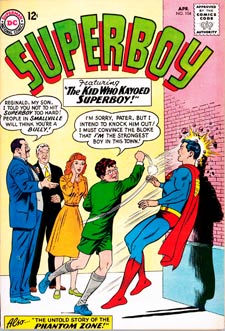 The
Untold Story of the Phantom Zone/The Kid Who Kayoed Superboy
The
Untold Story of the Phantom Zone/The Kid Who Kayoed Superboy
The origin of the Phantom Zone is revealed
in Superboy #104 (Apr. 1963), although you'd never
guess it from the cover.
The Silver Age of Superman was famous
for its misleading covers, of course, but usually they'd
feature some impossibly bizarre scene to draw you in, then
inside the book all manner of unlikely, implausible happenstance
would unfold to get you somehow to that scene. The impression
I always got was that editor Mort Weisinger would
say, "We can sell a million copies if we put X on the
cover, so that's what we're going to do. Now go and write
a story that gets us there."
This one seems to turn that tradition on its head, picking
easily the least interesting moment in a book full of amazing
goings on and giving it the spot of honor. Thus a fascinating
examination of one of the key elements of the mythos, to
say nothing of the potentially disastrous arrival on Earth
of three Kryptonian super-villains, is hidden behind the
umpteenth variation on "How can the new kid in Smallville
be stronger than our hero?" (Yawn)
The story itself begins in the past, and deep in space,
where we see a still-living planet Krypton encircled by
scads of eerie satellites; the orbiting, coffin-like "cells"
of Krypton's worst criminals.
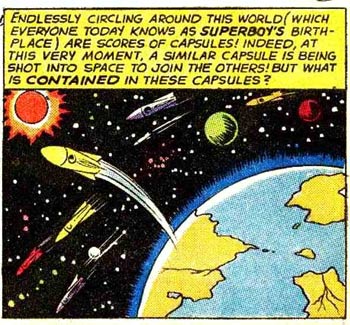
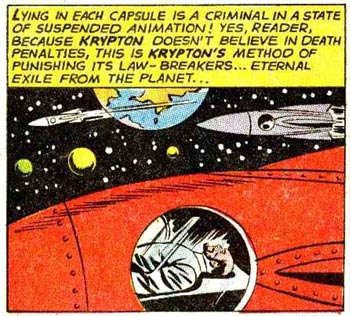
The key to this rather expensive-looking penal system is
a gas that induces suspended animation, a gas developed
by none other than Jor-El, who as its creator
has drawn the duty of administering the substance, thus
making him Krypton's official "executioner." (You
know, just like we made Robert Oppenheimer drop the atomic
bomb himself)
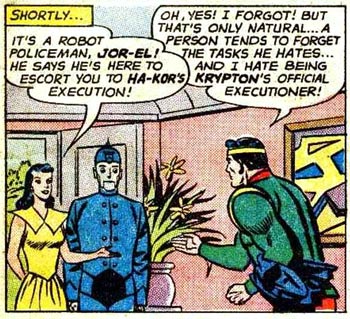
And thus begins a long series of confusing references in
this story. Krypton, it is repeatedly stressed, "does
not believe in killing its criminals," and yet it's
made equally clear that no one ever wakes up from Jor-El's
gas, and their capsules, says a judge, "can never return
to Krypton!" So what, you may ask, is the difference
between this punishment and the death penalty?
Anyway it's certainly the question on the mind of one prisoner,
who pleads for mercy:
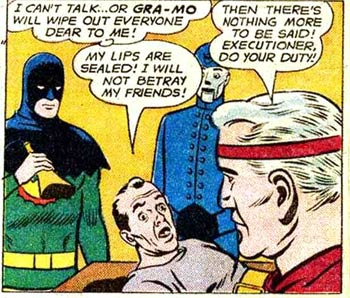
Curiously, even though Jor-El owes his "executioner"
duties to his fame as the inventor of the "suspended
animation" gas, he nonetheless wears a Medieval-style
black hood, presumably to preserve his anonymity. Indeed
the prisoner fails to recognize him, despite the fact that
the hood only covers the top half of his family crest, and
exposes 90% of the only suit he's known to wear 365 days
a year.
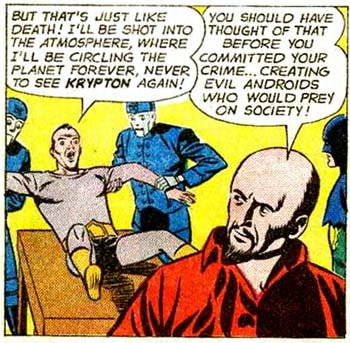
Note again the hypocrisy as the official refers to the
administering of the "non-fatal" gas as an "execution".
Indeed, even as he slips into his eternal sleep, the prisoner
asks, "Where's Jor-El? Long ago, he promised to invent
a less cruel method of punishment! Why hasn't he kept his
promise!" Which naturally makes Jor feel like a total
heel.
As the capsule speeds away, Jor-El lets the judge know
he's nearly perfected a new device that will vastly improve
this situation, one that "will send a criminal away
from Krypton for any length of time...yet bring him back
when his sentence is up!"
This device, of course, is the Phantom Zone projector,
capable of beaming persons into another dimension where
they remain alive, but only as intangible wraiths incapable
of communicating with the physical world. Before presenting
the gadget to the Science Council, though, Jor-El decides
to test it out...on himself. As we learn, this is perhaps
not the brightest plan a "brilliant scientist"
ever concocted, since he's the only one who understands
the technology.
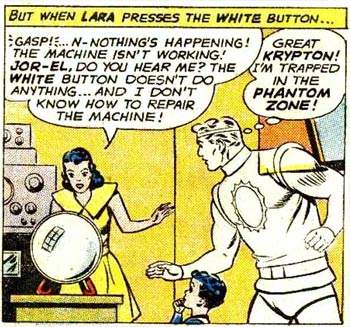
This being 1963, Lara of course knows
nothing about "man stuff" like science, and has
been told simply to press one button to "send"
and the other to "bring back." Ooops. As it turns
out, young Kal-El has removed a piece of
the projector, temporarily disabling it. Luckily he alerts
Lara to this fact by announcing "Haha! Me play with
little ball," in a typically naturalistic line of Silver
Age "toddler" dialog. With the "little ball"
re-inserted into the projector, it functions normally again.
Back in the land of the living, Jor-El presents his projector
to the Science Council, earning himself a position among
its august ranks. Unfortunately, use of the projector seems
to have accidentally ruined the invention of another Council
aspirant, Gra-Mo, secretly the leader of
Krypton's worst criminal gang.
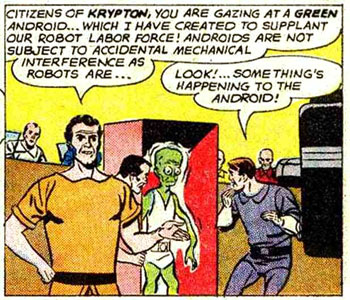
When he fails to be appointed to the Council (which he
secretly hoped to control), Gra-Mo uses a telepathic helmet
to compel the entire robot police force of Kryptonopolis
to take over the city for him. Jor-El defeats his plans
in spectacular fashion, gathering up all the robot police
with a magnetic satellite and dumping them into Krypton's
"fire falls". After a swift trial, Gra-Mo and
his two accomplices are sentenced to be the first prisoners
exiled to the Phantom Zone. Unfortunately a malfunction
in the projector means they have to be shot into orbit instead,
in the old-fashioned method.
In the months that follow, other criminals are exiled to
the Zone, and one day as Jor-El lies in a weakened state
thanks to fever, they team up to telepathically command
him to release them. Lara stops him, but aghast at what
almost happened, Jor-El launches the projector into space.
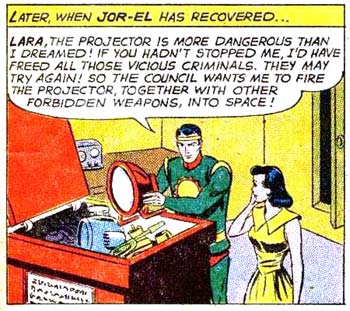
As longtime Superman readers will know, this box would
prove a font for all sorts of stories, but let's take a
moment to consider what's happening here. Having at last
perfected a more "humane" method of dealing with
criminals, a method which allows for parole and release
where the old one did not, Jor-El and the Council have now
decided to send the projector into space, thus -- for all
they know -- removing forever the possibility that the prisoners
can be released from the Zone.
As we'll see in other stories, not every Phantom Zone prisoner
was given a life sentence, and at least one was wrongly
convicted; those poor souls are now condemned to the same
fate as Krypton's worst murderers and traitors. Apparently
this was done to explain a "loophole" that young
readers would otherwise have pounced on. As Jor-El rockets
Kal-El away from dying Krypton, he says, "It's a pity
we haven't the machine I invented so we could project Krypton's
people into the Phantom Zone where at least they would remain
alive!"
Anyway, as we all know, the bad guys get the last laugh
as they survive while Jor-El and the "good" people
of Krypton are lost. Indeed, not only do the Zone prisoners
survive, but so do Gra-Mo and his pals, luckily spun from
orbit by the blast in their special economy 3-for-1 capsule.

The years pass, and Kal-El grows to a teenager in Smallville.
Then one day Gra-Mo's capsule wanders into our solar system,
where a chance collision with a meteor sends it hurtling
to Earth. Awakening, the prisoners discover their new super-powers
and correctly attribute them to the influence of Earth's
yellow sun. Superboy comes to investigate and accepts the
three as "old friends" of Jor-El who admired his
creation of the Phantom Zone projector.

Gra-Mo and his pals ask Superboy to keep their arrival
to himself while they train themselves in the use of their
new powers. As soon as he flies off, however, they plot
against him: "Jor-El is dead, but we can revenge ourselves
against him by destroying his son!" they scheme, in
one of several scenes that foreshadow the film, Superman
II.
Gra-Mo builds a new telepathic helmet and contacts Jax-Ur
in the Phantom Zone, who gives him the inside scoop on Kryptonite
and prescribes a temporary antidote for its effects. Then
they set in motion a plot to remove Superboy's interference
so they can take over the Earth.
The next day, an Englishman appears in Smallville with
his young son, a bespectacled nebbish in knee pants and
bow tie who surprises everyone by exhibiting a super-strength
that rivals Superboy's. When "Reggie" starts creating
havoc in town, Superboy shows up to stop him, and takes
that punch on the chin we saw on the cover.
When Reggie dares Superboy to hit him back, our hero answers,
"You have a lesson coming to you! Since you obviously
do have some sort of super-strength, one punch will probably
do nothing worse than knock you out for a moment!"
So he hits the kid, with disastrous results.

Now it's anyone's guess why Superboy thought super-strength
was the same thing as invulnerability. By this point, he's
met any number of strong characters who aren't invulnerable
(like Samson), so why would he assume this one is? Also
it's unclear how you could hit someone hard enough to knock
them skyward at super-speed, but not enough to kill them
on contact (Reggie seems to be alive after the punch, and
screams from the heat of air friction).
Anyway, Superboy honors his long-standing pledge to give
up his career as a superhero if he ever causes a death,
which is exactly what Gra-Mo was hoping for. Turns out the
"Englishman" was Gra-Mo in disguise, and his son
"Reggie" was a specially-constructed android,
just "lifeless chemical protoplasm" controlled
by one of his accomplices with the telepathic helmet. With
Superboy out of the picture, the Kryptonian villains run
riot in Smallville.

Really, Earl? Is that what it is? There's always one guy
like this in every story, isn't there? Before the villains
showed up, he was probably saying, "Hello, you're Ralph,
the salesman from the department store down the street.
That's the hat your wife bought you."
The robbery doesn't get far before Superboy shows up, having
figured out Gra-Mo's ruse with the android. Outnumbered
3-to-1 with the fate of the Earth in the balance, Superboy
calls upon his great skill as a combat tactician and engages
Gra-Mo in a two-handed contest of "Uncle."

When that doesn't work, he tries to even the odds with
his Superboy robots, but Gra-Mo neutralizes them by creating
solar flares that disable their mechanisms. Then he tries
Green Kryptonite, but the villains are immune thanks to
Jax-Ur's antidote. With Superboy seemingly stymied, the
criminals hear a summons from their Phantom Zone buddies
telling them Superboy has hidden the Phantom Zone projector
in their prison ship. They run to fetch it, but find it's
a fake.
With the criminals still inside the ship, Superboy coats
it with "a new, plastic, super-opaque paint I invented
that will prevent any sunlight from entering the capsule!"

With the source of their powers removed, the criminals
are unable to escape the ship, and Superboy beams them,
ship and all, into the Phantom Zone. And all's well that
ends well.
Of course this seems a bit inconsistent with what we know
about Kryptonian's powers. After all, Superboy's been locked
away in dungeons and basements and coffins and who knows
what all, well out of the sunshine, and he didn't automatically
lose his powers. To me, this is like plotting to rob George
Hamilton of his tan by locking him in a closet for 30 seconds.
Nonetheless, this is a fantastic story, at least for me,
literally crammed full of amazing stuff including a lot
of debate-worthy revelations about Kryptonian "justice",
a heroic escapade for Jor-El, a showdown with three super-powered
criminals and overall just a truly epic feel for a comic
that, again, seems to promise so very little on the cover.
It's anyone's guess why they didn't choose a cover image
showing one of the many, many more awesome moments in this
tale, like a fight with the three villains, or maybe the
villains laying waste to Earth while an agonized Superboy
stands by helplessly moaning, "I've sworn not to interfere!"
Or heck, even Superboy punching Reggie to the stratosphere
as horrified onlookers gasp, "You...you've killed him!"
If it is indeed true, as I suspect, that the covers came
first and the stories were written around them, maybe this
is writer Edmond Hamilton's way of sticking
it to Mort, writing a story so awesome the cover actually
sells it short. A lot of the awesomeness comes from the
art, this time contributed by both of Superboy's finest
delineators, George Papp in part one and
Curt Swan
(with George Klein) in part two.
What really lingers, though, is the sense that Krypton
was full of a lot of namby-pambys without the courage to
face hard choices, clinging to euphemisms because they "don't
believe in the death penalty." Just things exactly
like it, or worse.















